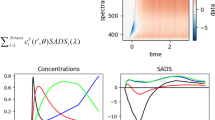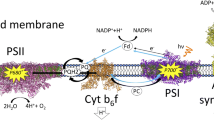Abstract
The Siberian hamster ultraviolet (SHUV) visual pigment has an unprotonated Schiff-base (SB) retinyl chromophore in the dark state, which becomes protonated after photoexcitation during the early stages of the photobleaching cycle. While the photochemical relaxation processes of the SHUV remain poorly understood, they are expected to show significant differences when compared to those of the protonated SB (PSB) chromophore in visual rhodopsin. Here, we report a study of the photophysical properties of the SHUV unprotonated SB (SHUV-USB), based on multiconfigurational and multireference perturbative methods within a hybrid quantum mechanics/molecular mechanics scheme. Comparisons of multireference and time-dependent density functional theory results indicate that both methodologies predict an ionic excited state (S1), similar to the PSB of rhodopsin, although its minimum has even bond-lengths in the central region of the retinyl polyene chain. The analysis of excited-state manifolds at the Franck–Condon region and S1 minimum configuration indicates that the skeletal relaxation initiated in the S1 surface is likely to involve S1/S2 surface crossing. These results provide valuable insights for future studies of the SHUV-USB photoisomerization mechanism.






Similar content being viewed by others
References
Okada T, Sugihara M, Bondar AN, Elstner M, Entel P, Buss V (2004) The retinal conformation and its environment in rhodopsin in light of a new 2.2 angstrom crystal structure. J Mol Biol 342(2):571–583
Bowmaker JK (1998) Evolution of colour vision in vertebrates. Eye 12:541–547
Hunt DM, Wilkie SE, Bowmaker JK, Poopalasundaram S (2001) Vision in the ultraviolet. Cell Mol Life Sci 58(11):1583–1598
Mooney V, Sekharan S, Liu J, Guo Y, Batista VS, Yan ECY (2015) Kinetics of thermal activation of an ultraviolet cone pigment. J Am Chem Soc 137(1):307–313
Sekharan S, Mooney VL, Rivalta I, Kazmi MA, Neitz M, Neitz J, Sakmar TP, Yan ECY, Batista VS (2013) Spectral tuning of ultraviolet cone pigments: an interhelical lock mechanism. J Am Chem Soc 135(51):19064–19067
Mooney VL, Szundi I, Lewis JW, Yan ECY, Kliger DS (2012) Schiff base protonation changes in Siberian hamster ultraviolet cone pigment photointermediates. Biochemistry 51(12):2630–2637
Birge RR (1990) Photophysics and molecular electronic applications of the rhodopsins. Annu Rev Phys Chem 41:683–733
Briand J, Bram O, Rehault J, Leonard J, Cannizzo A, Chergui M, Zanirato V, Olivucci M, Helbing J, Haacke S (2010) Coherent ultrafast torsional motion and isomerization of a biomimetic dipolar photoswitch. Phys Chem Chem Phys 12(13):3178–3187
Lumento F, Zanirato V, Fusi S, Busi E, Latterini L, Elisei F, Sinicropi A, Andruniow T, Ferre N, Basosi R, Olivucci M (2007) Quantum chemical modeling and preparation of a biomimetic photochemical switch. Angew Chem Int Ed 46(3):414–420
Sinicropi A, Martin E, Ryazantsev M, Helbing J, Briand J, Sharma D, Leonard J, Haacke S, Cannizzo A, Chergui M, Zanirato V, Fusi S, Santoro F, Basosi R, Ferre N, Olivucci M (2008) An artificial molecular switch that mimics the visual pigment and completes its photocycle in picoseconds. Proc Natl Acad Sci USA 105(46):17642–17647
Ahuja S, Smith SO (2009) Multiple switches in G protein-coupled receptor activation. Trends Pharmacol Sci 30(9):494–502
Tomasello G, Olaso-Gonzalez G, Altoe P, Stenta M, Serrano-Andres L, Merchan M, Orlandi G, Bottoni A, Garavelli M (2009) Electrostatic control of the photoisomerization efficiency and optical properties in visual pigments: on the role of counterion quenching. J Am Chem Soc 131(14):5172–5186
Roos BO (1987) Ab initio methods in quantum chemistry: part II. Wiley, Chicester
Andersson K, Malmqvist PA, Roos BO (1992) 2nd-order perturbation-theory with a complete active space self-consistent field reference function. J Chem Phys 96(2):1218–1226
Huix-Rotllant M, Filatov M, Gozem S, Schapiro I, Olivucci M, Ferre N (2013) Assessment of density functional theory for describing the correlation effects on the ground and excited state potential energy surfaces of a retinal chromophore model. J Chem Theory Comput 9(9):3917–3932
Rivalta I, Nenov A, Garavelli M (2014) Modelling retinal chromophores photoisomerization: from minimal models in vacuo to ultimate bidimensional spectroscopy in rhodopsins. Phys Chem Chem Phys. doi:10.1039/c1033cp55211j
Yanai T, Tew DP, Handy NC (2004) A new hybrid exchange-correlation functional using the Coulomb-attenuating method (CAM-B3LYP). Chem Phys Lett 393(1–3):51–57
Rostov IV, Amos RD, Kobayashi R, Scalmani G, Frisch MJ (2010) Studies of the ground and excited-state surfaces of the retinal chromophore using CAM-B3LYP. J Phys Chem B 114(16):5547–5555
Altoe P, Stenta M, Bottoni A, Garavelli M (2007) A tunable QM/MM approach to chemical reactivity, structure and physico-chemical properties prediction. Theor Chem Acc 118(1):219–240
Hornak V, Abel R, Okur A, Strockbine B, Roitberg A, Simmerling C (2006) Comparison of multiple amber force fields and development of improved protein backbone parameters. Proteins: Struct Funct Bioinform 65(3):712–725
Senn HM, Thiel W (2009) QM/MM methods for biomolecular systems. Angew Chem Int Ed 48(7):1198–1229
Aquilante F, Autschbach J, Carlson R, Chibotaru L, Delcey MG, De Vico L, Fernández Galvan I, Ferré N, Frutos LM, Gagliardi L, Garavelli M, Giussani A, Hoyer C, Li Manni G, Lischka H, Ma D, Malmqvist PA, Müller T, Nenov A, Olivucci M, Pedersen TB, Peng D, Plasser F, Pritchard B, Reiher M, Rivalta I, Schapiro I, Segarra-Martí J, Stenrup M, Truhlar DG, Ungur L, Valentini A, Vancoillie S, Veryazov V, Vysotskiy V, Weingart O, Zapata F, Lindh R (2016) Molcas 8: new capabilities for multiconfigurational quantum chemical calculations across the periodic table. J Comput Chem 37(5):506–541
Karlstrom G, Lindh R, Malmqvist PA, Roos BO, Ryde U, Veryazov V, Widmark PO, Cossi M, Schimmelpfennig B, Neogrady P, Seijo L (2003) MOLCAS: a program package for computational chemistry. Comput Mater Sci 28(2):222–239
Aquilante F, De Vico L, Ferre N, Ghigo G, Malmqvist PA, Neogrady P, Pedersen TB, Pitonak M, Reiher M, Roos BO, Serrano-Andres L, Urban M, Veryazov V, Lindh R (2010) Software news and update MOLCAS 7: the next generation. J Comput Chem 31(1):224–247
Ghigo G, Roos BO, Malmqvist PA (2004) A modified definition of the zeroth-order Hamiltonian in multiconfigurational perturbation theory (CASPT2). Chem Phys Lett 396(1–3):142–149
Forsberg N, Malmqvist PA (1997) Multiconfiguration perturbation theory with imaginary level shift. Chem Phys Lett 274(1–3):196–204
Malmqvist PA, Roos BO (1989) The Casscf state interaction method. Chem Phys Lett 155(2):189–194
Malmqvist PA, Roos BO, Schimmelpfennig B (2002) The restricted active space (RAS) state interaction approach with spin-orbit coupling. Chem Phys Lett 357(3–4):230–240
Aquilante F, Lindh R, Pedersen TB (2007) Unbiased auxiliary basis sets for accurate two-electron integral approximations. J Chem Phys 127(11):114107
Aquilante F, Malmqvist PA, Pedersen TB, Ghosh A, Roos BO (2008) Cholesky decomposition-based multiconfiguration second-order perturbation theory (CD-CASPT2): application to the spin-state energetics of Co-III(diiminato)(NPh). J Chem Theory Comput 4(5):694–702
Foresman JB, Headgordon M, Pople JA, Frisch MJ (1992) Toward a systematic molecular-orbital theory for excited-states. J Phys Chem 96(1):135–149
Frisch MJ, Trucks GW, Schlegel HB, Scuseria GE, Robb MA, Cheeseman JR, Scalmani G, Barone V, Mennucci B, Petersson GA, Nakatsuji H, Caricato M, Li X, Hratchian HP, Izmaylov AF, Bloino J, Zheng G, Sonnenberg JL, Hada M, Ehara M, Toyota K, Fukuda R, Hasegawa J, Ishida M, Nakajima T, Honda Y, Kitao O, Nakai H, Vreven T, Montgomery JA Jr, Peralta JE, Ogliaro F, Bearpark M, Heyd JJ, Brothers E, Kudin KN, Staroverov VN, Kobayashi R, Normand J, Raghavachari K, Rendell A, Burant JC, Iyengar SS, Tomasi J, Cossi M, Rega N, Millam JM, Klene M, Knox JE, Cross JB, Bakken V, Adamo C, Jaramillo J, Gomperts R, Stratmann RE, Yazyev O, Austin AJ, Cammi R, Pomelli C, Ochterski JW, Martin RL, Morokuma K, Zakrzewski VG, Voth GA, Salvador P, Dannenberg JJ, Dapprich S, Daniels AD, Farkas Ö, Foresman JB, Ortiz JV, Cioslowski J, Fox DJ (2009) Gaussian 09, Revision A.1. Gaussian, Inc., Wallingford, CT
Serrano-Andres L, Merchan M, Lindh R (2005) Computation of conical intersections by using perturbation techniques. J Chem Phys 122(10):104107
Mathies RA (1999) Photons, femtoseconds and dipolar interactions: a molecular picture of the primary events in vision. Novartis Found Symp 224:70–84 discussion 84–101
Mathies R, Stryer L (1976) Retinal has a highly dipolar vertically excited singlet-state: implications for vision. Proc Natl Acad Sci USA 73(7):2169–2173
Hufen J, Sugihara M, Buss V (2004) How the counterion affects ground- and excited-state properties of the rhodopsin chromophore. J Phys Chem B 108(52):20419–20426
Polli D, Altoe P, Weingart O, Spillane KM, Manzoni C, Brida D, Tomasello G, Orlandi G, Kukura P, Mathies RA, Garavelli M, Cerullo G (2010) Conical intersection dynamics of the primary photoisomerization event in vision. Nature 467(7314):U440–U488
Huntress MM, Gozem S, Malley KR, Jailaubekov AE, Vasileiou C, Vengris M, Geiger JH, Borhan B, Schapiro I, Larsen DS, Olivucci M (2013) Toward an understanding of the retinal chromophore in rhodopsin mimics. J Phys Chem B 117(35):10053–10070
Segarra-Martí J, Garavelli M, Aquilante F (2015) Multiconfigurational second-order perturbation theory with frozen natural orbitals extended to the treatment of photochemical problems. J Chem Theory Comput 11(8):3772–3784
González-Ramírez I, Segarra-Martí J, Serrano-Andrés L, Merchan M, Rubio M, Roca-Sanjuán D (2012) On the N1–H and N3–H bond dissociation in uracil by low energy electrons: a CASSCF/CASPT2 study. J Chem Theory Comput 8(8):2769–2776
Acknowledgments
V.S.B. acknowledges supercomputer time from NERSC and the Yale High Performance Computing Center, and support from NSF Grant CHE-1465108. MG acknowledges support by the European Research Council Advanced Grant STRATUS (ERC-2011-AdG No. 291198). IR gratefully acknowledges the support of the École Normale Supérieure de Lyon (Fonds Recherche 900/S81/BS81-FR14). We acknowledge the use of HPC resources of the “Pôle Scientifique de Modélisation Numérique” at the ENS-Lyon, France.
Author information
Authors and Affiliations
Corresponding author
Additional information
Published as part of the special collection of articles “Health & Energy from the Sun.”
Rights and permissions
About this article
Cite this article
Bonvicini, A., Demoulin, B., Altavilla, S.F. et al. Ultraviolet vision: photophysical properties of the unprotonated retinyl Schiff base in the Siberian hamster cone pigment. Theor Chem Acc 135, 110 (2016). https://doi.org/10.1007/s00214-016-1869-x
Received:
Accepted:
Published:
DOI: https://doi.org/10.1007/s00214-016-1869-x




